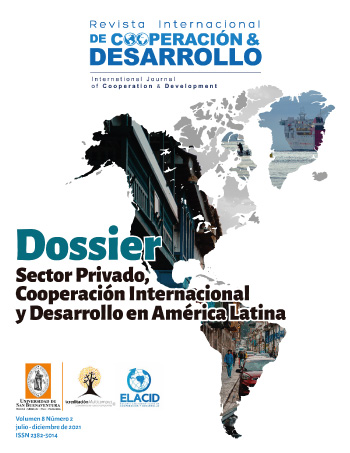INTERNATIONAL JOURNAL OF COOPERATION AND DEVELOPMENT
Assignment of Rights
Authorization for reproduction, publication, communication and distribution of a literary, artistic or scientific
Work.
I , ____________________________________________, author of the book and / or article , of legal age , resident of the city of _________________ , identified with citizenship / passport n° ______________________ issued on _______________________, in exercise of his physical and mental faculties , part henceforth be called the AUTHOR , supports the following authorization to the reproduction, publication, communication and distribution of a work, perform the following terms:
1. Regardless of current legal regulations due to the linking of the parties to this contract, and any kind of legal presumption , the parties agree that the AUTHOR authorize ( name of the publisher ) to reproduce , publish , communicate and distribute the material referred to in the International Journal of Cooperation and Development of the University of San Buenaventura.
2. Such authorization lies in particular on the copyright of the work, by any means known or unknown, publication of the work, distribution of the work , either directly or through third parties for purely educational purposes.
3. AUTHOR agrees to report and declare the existence of this authorization and to preserve the right of the International Journal of Cooperation and Development of the first publication of the work.
4. AUTHOR declares that the article is original and that it is his sole creation, no impediment of any kind exist for the authorization he is doing, besides being responsible for any action claim, plagiarism or other type of claim that might arise about .
5. Such permission is free of charge.
6. Moral copyright in the article are solely the AUTHOR and the University of San Buenaventura expressly agrees to recognize and respect them rigorously.
The Author and / or AUTHORS
SIGNATURE
Abstract
The objective of this article is to analyze the relationship between resource nationalism and sustainable development in five Andean countries (Colombia, Ecuador, Peru, Bolivia and Chile), before, during and after the commodity prices boom. The working hypothesis, formulated against the current neoliberal vision of the resource curse, is that there is no correspondence between the high dependence on resources, nationalist styles of governance and the blockade of sustainable development. The article concludes with a preliminary assessment of economic, social and environmental performance that confirms the hypothesis. This means that institutional designs are a constraint that can and must be modified by the collective agency so that sovereign governance over natural resources fulfills its social-developmentalist purposes as evidenced by the opposing cases of Ecuador and Chile.
Keywords: resource nationalism, governance, sustainable development, extractivism, institutionalist political economy
References
Arbatli, E. (2018). Resource nationalism revisited: A new conceptualization in light of changing actors and strategies in the oil industry. Energy Research and Social Science, 40, pp. 101-108.
Azqueta, D. & Sotelsek, D. (2019). Recursos minerales: capacidad de carga y desarrollo sostenible. En R. J. Sánchez (ed.), La bonanza de los recursos naturales para el desarrollo. Dilemas de gobernanza. Santiago de Chile: CEPAL, pp. 29-57.
Ballón, E. et al. (2017). Minería y marcos institucionales en la región andina. El superciclo y su legado, o las difíciles relaciones entre políticas de promoción de la inversión minero-hidrocarburífera y las reformas institucionales. Reporte de investigación. Lima: Natural Resource Governance Insitute, Oficina Regiona América Latina.
— (2018). La Agenda de la Sociedad Civil frente a las Industrias Extractivas en América Latina. Lima, Natural Resources Governance Institute.
Bárcena, A. & Cimoli, M. (2022). Repensar el desarrollo a partir de la igualdad. El Trimestre Económico, 89(353-1), pp. 19-37.
Biresselioglu, M. E. et al. (2019). How vulnerable are countries to resource curse?: A multidimensional assessment. Energy Research & Social Science, 47, pp. 93-101.
Campodónico, H. (2016). Recuperar la soberanía sobre los recursos naturales: los casos de Bolivia y el Ecuador. Centro del Sur Documento de Investigación, 71.
Casanova, C., Xia, L. & Ferreira, R. (2015). Measuring Latin America’s export dependency on China. BBVA Research Working Paper, 15/26.
Ceccini, S. & Atuesta, B. (2017). Programas de transferencias condicionadas en América Latina y el Caribe Tendencias de cobertura e inversión. Santiago de Chile: CEPAL.
CEPAL. (2014). Panorama Social de América Latina y el Caribe 2014. Santiago de Chile: CEPAL.
CEPAL. (2015a). Panorama Fiscal de América Latina y el Caribe 2015. Dilemas y espacios de políticas. Santiago de Chile: CEPAL y Cooperación Española.
CEPAL. (2015b). Anuario Estadístico de América Latina y el Caribe 2015. Santiago de Chile: CEPAL.
CEPAL. (2019). Panorama Social de América Latina 2018, Santiago de Chile: CEPAL.
Chang, H. J. (2002). Breaking the mould: an institutionalist political economy alternative to the neoliberal theory of the market and the state. Cambridge Journal of Economics, 26(4), pp. 539-559.
— (2011). Institutions and Economic Development: Theory, Policy and History. Journal of Institutional Economics, 7(4), pp. 473-498.
Childs, J. (2016). Geography and resource nationalism: A critical review and reframing. The Extractive Industries and Society, 3(2), pp. 539-546.
De la Puente, L. & Ballón, E. (2019). La gobernanza centralizada de la minería, el gas y el petróleo en los países andinos: ¿Oportunidades de transformación? Lima: Natural Resource Governance Institute.
De la Torre, A. et al. (2015). América Latina y el ascenso del Sur. Nuevas prioridades en un mundo cambiante. Washington: World Bank Group.
Dietsche, E. (2018). Political Economy and Governance. En T. Addison & A. Roe (eds.), Extractive Industries. The Management of Resources as a Driver of Sustainable Development. Oxford: Oxford University Press, pp. 114-136.
Domínguez, R. (2021). América Latina y la maldición de los recursos: el debate en la larga duración. El Trimestre Económico, 88(351-3), pp. 769-806.
Domínguez, R. et al. (2019). Recursos naturales, medio ambiente y sostenibilidad. 70 años de pensamiento de la CEPAL. Santiago de Chile: CEPAL.
Domínguez, R. & Caria, S. (2016). Extractivismos andinos y limitantes del cambio estructural. En H. J. Burchardt et al. (eds.), Nada dura para siempre. Neo-extractivismo tras el boom de las materias primas. Quito: Universidad Andina Simón Bolívar y Universität Kassel, pp. 89-130.
Estay, J. (2018). Past and Present of Latin American Regionalisms, in the Face of Economic Reprimarization. En E. Vivares (ed.), Regionalism, Development and the Post-Commodities Boom in South America, Cham: Palgrave MacMillan, pp. 47-76.
Fontaine, G., Medrano, C. & Narváez, I. (2020). The Politics of Public Accountability. Policy Design in Latin American Oil Exporting Countries. Cham: Palgrave McMillan.
Gabor, D. (2021). The Wall Street Consensus. Development and Change, 52(3), pp. 429-459.
Gorenstein, S. & Ortiz, R. (2018). Natural resources and primary sector-dependent territories in Latin America. Area Development and Policy, 3(1), pp. 42-59.
Fukuyama, F. (2013). What is Governance. Governance: An International Journal of Policy, Administration and Institutions, 26(3), pp. 347-368.
Gómez, J. C. & Rossignolo, D. (2015). La tributación sobre las altas rentas en América Latina. En, J. P. Jiménez (ed.), Desigualdad, concentración del ingreso y tributación sobre las altas rentas en América Latina. Santiago de Chile: CEPAL y Centro de Estudios Fiscales, pp. 49-116.
González, N. (2019). La conflictividad vinculada a los recursos naturales en América Latina: tendencias y mecanismos institucionales de respuesta. En, R. J. Sánchez (ed.), La bonanza de los recursos naturales para el desarrollo. Dilemas de gobernanza. Santiago de Chile: CEPAL, pp. 359-372.
Hailu, D. & Kipgen, C. (2017). The Extractives Dependence Index (EDI). Resources Policy, 51, pp. 251-264.
Hanni, M., Jiménez, J. P. & Ruelas, I. (2019). Regímenes fiscales vinculados a los recursos naturales no renovables en América Latina y el Caribe y su relación con el ciclo de precios: evolución reciente y desafíos pendientes. En R. J. Sánchez (ed.), La bonanza de los recursos naturales para el desarrollo. Dilemas de gobernanza. Santiago de Chile: CEPAL, pp. 95-317.
Haslam, P. A. & Heidrich, P. (2016). From neoliberalism to resource nationalism: states, firms and development. En P. A. Haslam & P. Heidrich (eds.), The Political Economy of Natural Resources and Development. From neoliberalism to resource nationalism. Nueva York: Routledge, pp. 1-32.
Hrotko, J. et al. (2018). Striking a Balance Between Well-Being and Growth. The 2018 Sustainable Development Economic Assessment. Boston: The Boston Consulting Group.
Kauffmann, D. (2017). Índice de la Gobernanza de los Recursos Naturales. Lima: Natural Resource Governance Institute.
Kitthananan, A. (2008). Developmental states and global neoliberalism”, en P. Kennett (ed.). Governance, Globalization and Public Policy. Cheltenham, Edward Elgar, pp. 77-103.
Koch, N. & Perreault, T. (2019). Resource nationalism. Progress in Human Geography, 43(4), pp. 611-631.
Kretzschmar, G. L., Kirchner, A. & Sharifzyanova, L. (2010). Resource Nationalism. Limits to Foreign Direct Investment. The Energy Journal, 31(2), pp. 27-52.
Lange, G. M., Wodon, Q. & Carey, K. (eds.). (2018). The Changing Wealth of Nations. Building a Sustainable Future. Washington: The World Bank.
Martins, P. M. G. (2015). Sub-Regional Perspectives on Structural Change, CREDIT Research Paper, 15/03.
Mkandawire, T. (2007). "Good governance": the itinerary of an idea. Development in Practice, 17(4/5), pp. 679-681.
Möhle, E. & Schteingart, D. (2021). Hacia un ecodesarrollismo latinoamericano. Nueva Sociedad, 295, pp. 42-56.
Obaya, M. (2021). The evolution of resource nationalism: The case of Bolivian lithium. The Extractives Industries and Society, 8(3), 10.1016/j.exis.2021.100932.
Ocampo, J.A. (2017a). Commodity-led Development in Latin America. En, G. Carbonnier, H. Campodónico & S. Tezanos (eds.), Alternative Pathways to Sustainable Development: Lessons from Latin America. Ginebra, Graduate Institute of International and Development Studies, pp. 51-76.
— (2017b). Latin America’s development: a short historical account. En V. Popov & P. Dutkiewicz (eds.), Mapping a New World Order. The Rest Beyond the West. Cheltenham: Edward Elgar, pp. 137-160.
Ocampo, J. A., Bastian, E. F. & Reis, M. (2018). The myth of the “Latin American decade”. PSL Quarterly Review, 71(285), pp. 231-251.
OCDE/CEPAL/CAF. (2015). Perspectivas económicas de América Latina 2016: Hacia una nueva asociación con China. París: OECD Publishing.
Palma, J. G. (2005). Four Sources of “De-Industrialization” and a New Concept of the “Dutch Disease”. En J. A. Ocampo (ed.), Beyond Reforms. Structural Dynamics and Macroeconomic Vulnerability. Washington: ECLAC, pp. 71-116.
— (2019). Desindustrialización, desindustrialización “prematura” y “síndrome holandés”. El Trimestre Económico, 86(344-3), pp. 901-966.
Petras, J. & Veltmeyer, H. (2014). Extractive Imperialism in the Americas. Capitalism’s New Frontier. Leyden y Boston: Brill.
Pryke, S. (2017). Explaining Resource Nationalism. Global Policy, 8(4), pp. 474-482.
Resource Watch Institute. (2013). Índice de la Gobernanza de los Recursos Naturales. Nueva York: RWI.
Rodrik, D. (2016). Premature Deindustrialization. Journal of Economic Growth, 21(1), pp. 1-33.
Rosales, A. (2020). Structural constraints in times of resource nationalism: oil policy and state capacity in post-neoliberal Ecuador.Globalizations, 17(1), pp. 77-92.
UNDP. (2010). Human Development Report 2010 20th Anniversary Edition. The Real Wealth of Nations: Pathways to Human Development. Nueva York: Palgrave Macmillan.
UNDP. (2015). Human Development Report 2015. Work for Human Development. Nueva York: United Nations Development Programme.
UNDP. (2018). Human Development Indices and Indicators. 2018 Statistical Update. Nueva York: United Nations Development Programme.
World Bank. (2006). Where is the Wealth of Nations? Measuring Capital for the 21st Century. Washington: The World Bank.
— (2011). The Changing Wealth of Nations. Measuring Sustainable Development in the New Millennium. Washington: The World Bank.
Vernengo, M. (2018). ¿La “trampa del ingreso medio” o el retorno de la hegemonía estadounidense? Coyuntura y Desarrollo, 385, pp. 171-178.
Young, K.A. (2017). Blood of the Earth: Resource Nationalism, Revolution, and Empire in Bolivia. Austin: University of Texas Press.
















